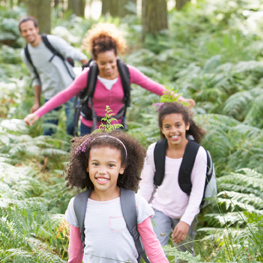
Do you want to go on a real-life treasure hunt? Then you have gotta try geocaching! If you’ve never heard of it, it is an activity loved by people of all ages across the globe. Best of all, it’s practically free to do, is a great way to get some exercise and is especially good as a family activity.
Geocaching is an outdoor game using a GPS-enabled device using coordinates to find ‘the treasure’ (the geocache). At first, geocaching was done with a handheld GPS - and some people still use them - but now geocaching is extremely easy using a smartphone; simply download the free app and you’re ready to begin! The geocache is a container hidden at a specific location and found using GPS coordinates. Geocaches are never buried but can be hidden in parks, near sites of interest or at the end of a pleasant walk. They are often camouflaged. The container contains a logbook for people to sign, and also contains small treasures for people to trade. The general rule of geocaching etiquette is if you take a treasure - known in geocaching terms as ‘swag’- you need to leave something of equal value or better than the item taken. If you have nothing to trade, then the rule is to take nothing and simply sign the logbook. Dollar Stores, for example, are great places to purchase geocaching items: hair barrettes, small plastic animals, key chains, mini playing cards, brain teaser puzzles and golf balls are all great ideas. Many geocachers also hand-make items such as magnets, key chains and painted rocks - there are so many ways to use your creativity! However, liquid items, like bubble mixture, anything edible such as chocolate and even bars of soap, should not be left in a cache. If they leak, it could ruin the cache and can attract animals.
The image that most people have of geocaching is that it requires a lot of hiking in a remote area, but that isn’t necessarily the case. There are caches in National and Provincial Parks, but there are hundreds of caches placed right here in Calgary, including City parks. Karen Ung, a local outdoor writer (for great information for outdoor families, visit her blog: Play Outside Guide, playoutsideguide.com), regularly geocaches with her children around Calgary and beyond. “Urban caching and rural caching are very similar. There are caches right on the side of the trail and others that require bushwhacking, so it is important to look at the difficulty and terrain ratings as well as the descriptions if you would like to stay closer to the trail - some will tell you the cache is 150 metres off trail, for example. In National Parks, caches are placed very close to the trail to prevent trail widening, so you can count on those to be fairly easy to find,” she says.
Geocaching with kids is a great way to get them used to hiking and navigating using geographical landmarks, especially when the promise of finding treasure at the end keeps them going. Geocaching in urban areas also has the appeal of the ability to bring a stroller and a baby carrier with you when geocaching on foot or when geocaching by bicycle. Start out small and find easy caches (the app gives good indicators as to difficulty level), then work your way up to finding caches of greater difficulty. Make sure you dress sensibly with appropriate footwear, and bring enough snacks and water with you to make the geocaching experience as fun as possible. It is also a good idea to bring your own pen or pencil to fill in the logbook just in case the one in the cache is missing or unusable. Don’t forget to snap a photo of your find and log it on the geocaching.com website!
Karen also advises that geocaching etiquette for everyone is extremely important. “In town, respect private property (no shortcuts through people’s yards!), and always cross the road safely. Don’t just follow your compass blindly across the street. Geocaching is based on the honor system so even though no one may be watching when you find the geocache, making good choices in making a trade [for items in the cache] and leaving the cache the way you found it is important.” Another great thing that geocachers can do is practice ‘cache in trash out.’Bring a garbage bag with you and pick up any litter you see on the trail to be good stewards of the land and leave the area in a better state than when you found it.
Geocaching is a great way to get to know Calgary’s communities and a great activity that families can do together to get outside and work as a team. Of course, finding treasure is a bonus!
Are you a geocaching newbie?
For more great tips on getting started, check out Karen Ung’s blog article, Geocaching 101: How to Geocache with Your Smart Phone, playoutsideguide.com/2014/11/geocaching-101-how-to-geocache-with.html.
Carla and her husband and son are new to geocaching, but are already dreaming of finding their next cache.
Calgary’s Child Magazine © 2024 Calgary’s Child